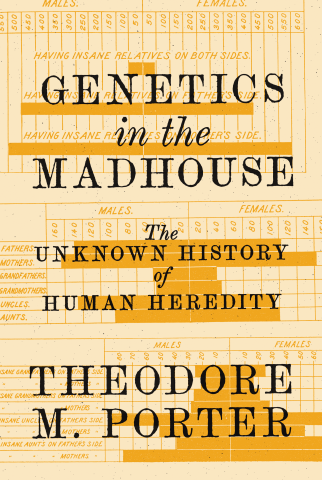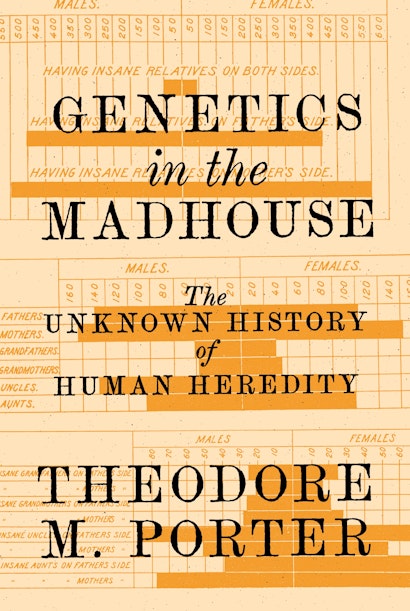In the early 1800s, a century before there was any concept of the gene, physicians in insane asylums began to record causes of madness in their admission books. Almost from the beginning, they pointed to heredity as the most important of these causes. As doctors and state officials steadily lost faith in the capacity of asylum care to stem the terrible increase of insanity, they began emphasizing the need to curb the reproduction of the insane. They became obsessed with identifying weak or tainted families and anticipating the outcomes of their marriages. Genetics in the Madhouse is the untold story of how the collection and sorting of hereditary data in mental hospitals, schools for “feebleminded” children, and prisons gave rise to a new science of human heredity. A bold rethinking of asylum work, Genetics in the Madhouse shows how heredity was a human science as well as a medical and biological one.
I can’t help noticing that the title of this book, Genetics in the Madhouse, incorporates a double anachronism.
TP: Well, yes, you’re right about that. Guilty as charged. The book begins in about 1789 which, besides being the year of the French Revolution, coincides pretty closely with a new model of care for the insane. These new institutions were not places of incarceration, but retreats or—the favorite word of the new era—asylums. They were idealized as orderly, restful places in the countryside where patients, laboring quietly, could recover their mental balance. In real life, it was scarcely possible to maintain order and quiet in these hospitals, especially as they grew to hold thousands of patients. The title word “madhouse” evokes the precarious situation of service personnel trying to apply psychological and moral principles to such recalcitrant populations. The most basic point of the book is that routines of record keeping in these disorderly establishments provided an indispensable basis of data for investigation patterns of biological inheritance. Although our word for this study, “genetics,” was first used by the naturalist William Bateson in 1905, biological heredity as a scientific problem had been taking shape for at least a century. Bateson chose to let this new science be defined by Gregor Mendel’s experiments on plant hybridization from the 1860s, which had changed everything, he said. I follow a recent turn of historical research that demonstrates a richer and more diverse tradition of hereditary study. My book emphasizes the key role of data gathering from mental hospitals and related institutions for this science of human heredity.
This is your fourth book with Princeton University Press, all of which have involved history of statistics, calculation, and measurement in the human sciences. Did you write this one to reveal the statistical background to genetics?
TP: In fact, the statistics of heredity was already an important topic of my first book, written in the late 1970s and early 1980s in the context of a very different historiography. Genetics in the Madhouse had its moment of inspiration a decade ago when it occurred to shift my emphasis from ideals of statistical reasoning to the production and deployment of medical and scientific data. Although I at first had no idea of this, data was just emerging as a focus of historical research. The history of data has and obvious connection to history of statistics, but it has, I would suggest, a certain primordial aspect. Statistics presupposes data, whereas there are other strategies besides statistics for reasoning with data. I ended up spending a lot of time in archives trying to figure out the protocol when, as it usually happened, a relative of a prospective patient supplied the medical superintendent of an asylum with information for a line in the hospital admission book. From this point of origin, I could see how unit entries were combined into medical-administrative tables, merged into census statistics, and recombined to get at the relations of different variables. I had supposed until recently that most doctors didn’t care much for statistics, but now I found that many asylum doctors at least took their numbers very seriously. I quickly discovered that what I had thought of as sources of data for statistical analysis were much more than this. The doctors were already deeply engaged in investigating relationship of heredity among the diagnosed insane decades before statisticians like Karl Pearson began asking them for data on heredity.
On this basis, I began the backward phase of my research, trying to establish when and where these tables of inheritance of first arose. One possible source, a very precise one, is the medical inquiries carried out about 1789 by Dr. William Black in response to a furor over the madness of King George III. A better answer would be to link it to the asylum movement and to new standards of record keeping for public institutions.
But do you really think that administrative records could provide the basis for a natural science such as genetics?
TP: Indeed that would be too simple. Quite a lot of the asylum record keeping really was passive and formulaic, but this was never the whole story. Black, who was responding to constitutional crisis, had to track down privately-held data from Bethlem (Bedlam) and assemble new tables giving evidence on the critical question of whether the king was likely to recover. By the 1830s, many asylum doctors understood their role not only in terms of relieving insane persons committed to their institutions, but also of advising the population at large on the preservation of mental health. Their interest in causes of insanity was allied to this public-health mission. Meanwhile, despite all the new asylums, insanity numbers were growing like crazy. It became more and more important to understand causes, especially hereditary ones. By the 1840s, a subset of asylum doctors were taking the study of heredity very seriously. While they depended on administrative records to keep tabs on the presumed causes, they also widened the field of data collection, for example to relative of patients. Insanity, and even its inheritance, became a topic for the national census. The doctors also worked to integrate data from diverse institutions and to track down every insane person in specific parishes in order to unravel the family relationships and reduce them to family trees or pedigrees. So the routine record keeping often went well beyond administrative routines.
Why did they become obsessed with hereditary causation?
TP: In fact, the inheritance of traits and diseases, including of mental illness, was already by 1800 a folk category. If a newly-admitted asylum patient had a sister or uncle who behaved oddly, spoke incoherently, or committed suicide, spouses and children often mentioned this as indicating a hereditary factor. Asylum doctors were in a position to gather up reports like these, and their tables often showed heredity as the most important cause of insanity. To be sure, such numbers depended also on the attitude of the doctor. Still, the numbers provided a basis for stern warnings against marrying into families plagued by hereditary weakness, and these were quite common by the 1840s. The reality of eugenics as a professional medical concern long predated the word.
Didn’t Charles Darwin’s cousin Francis Galton launch the eugenics movement?
TP: Certainly he was a key figure, and ever since 1900, when eugenics became famous, his name has been associated it. But it is unconvincing, and probably even a category mistake, to attribute a professional and popular movement like eugenics to the inspiration of any single individual. As it happens, Galton’s initial obsession with human heredity, and even his early methods for investigating it, owed something to the ideas and practices of asylum doctors. In the 1870s, when he carried out his study of the resemblances of twins, he knew enough to ask asylum directors and the families of patients for pertinent data. And Darwin, an early convert to Galton’s doctrines of inherited ability and weakness, had been worrying for decades about the possibility of hereditary weakness in his own family. He and his son George proposed studies using data from asylums and related institutions to determine if family marriages might bring on inherited weakness.
How long did it take for modern genetics to replace medical and social speculations about inherited weakness once Mendel’s laws at last were noticed in 1900?
TP: The first scientists to take up Mendelian research were botanists. It was quickly incorporated into agricultural research, and there were some real successes by the 1910s, most famously in research on mutations in fruit flies. Quick generation times and the possibility of rigorous experimental control were very important for Mendelian research. Some, such as Bateson, simply assumed that criminality must be controlled by a single gene. The first research on inheritance of insanity and mental weakness was carried out by allies of by Charles B. Davenport, founder of the well-funded Eugenics Record Office at Cold Spring Harbor in New York. He more or less assumed that conditions like these, with no evident bacteriological or environmental causes, must be hereditary, and in a straightforwardly Mendelian way. His data and much of the expertise to deploy it came from professionals at asylums and special schools, and thus was continuous with long-standing traditions of institutional research on heredity. The primary novelty was their strong expectation that Mendel’s characteristic ratios, 3:1 and 1:1, should spring out from breeding results. And that is what they found.
There followed an international wave of Mendelian psychiatry and psychology in Britain, Germany, Switzerland, and Scandinavia as well as North America. At first almost everyone succeeded in getting the results they were looking for, but these were harshly criticized, especially by Pearson and his allies in London. The most serious and expensive Mendelian studies were carried out in Germany, most famously by the Munich psychiatrist Ernst Rüdin in alliance with the doctor and statistician Wilhelm Weinberg. Their results for inheritance of mental illness (dementia praecox) were about six times smaller than they expected. Although they did not give up on Mendelism, they adopted for practical purposes a more empirical approach, measuring how the presence of a trait of interest in the parents affected the characters of the offspring, and ignoring for the time being the presumed genetic factors.
By about 1930, Davenport’s findings on Mendelian inheritance of mental defects had become a scandal. While geneticist continue often to speak loosely of genes for traits like these, and find it impossible to ignore them, there is no prospect of a simple Mendelian explanation of schizophrenia or learning disabilities. Meanwhile, statistical investigations of inheritance of mental and psychological traits go on.
Weren’t eugenic researches on inheritance of mental illness and disabilities discredited by the terrible abuses of the Nazis?
TP: While few these days are willing to own up to eugenic ambitions, eugenics never died. One of the first really terrible crimes of the Nazis was to murder hundreds of thousands of asylum patients. Genetics had some role in the justification and implementation of this policy, though rarely if ever let scientific arguments determine the implementation of policies like these. German research on psychiatric heredity from the Nazi period did not just disappear, but was cited and used for decades by researchers in Britain, Scandinavia, and North America, some of whom despised the medical-eugenic policies of the Nazi state.
Theodore M. Porter is Distinguished Professor of History and holds the Peter Reill Chair at the University of California, Los Angeles. His books include Karl Pearson: The Scientific Life in a Statistical Age, Trust in Numbers: The Pursuit of Objectivity in Science and Public Life, and The Rise of Statistical Thinking, 1820–1900 (all Princeton). He lives in Altadena, California.

